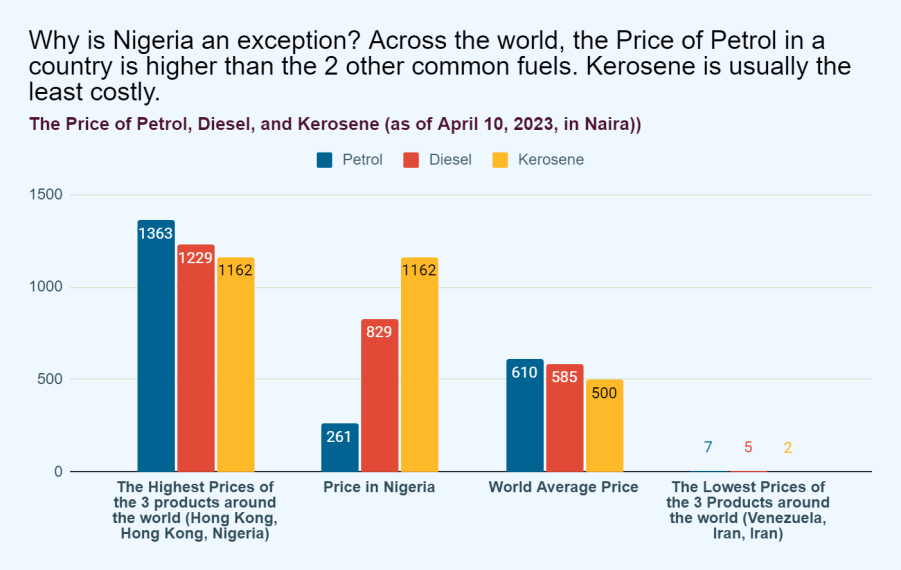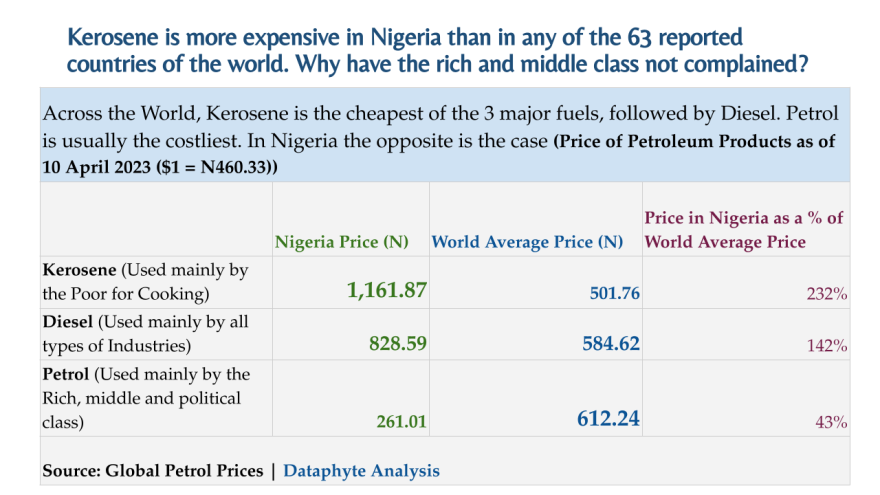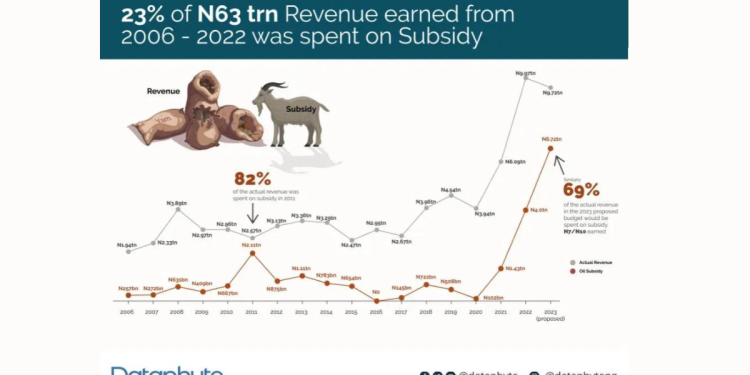There is something off about the price of petrol in Nigeria!
Can you spot it? 🔬
If we can spot it, it could help us decide whether the government should continue to subsidise the current pump price or instead impose taxes on petrol consumption.
This is it: All over the world, the price of petrol, diesel and kerosene are relatively close. Petrol has the highest price, followed by diesel and kerosene. In short, petrol is the costliest and kerosene is the cheapest.
In Nigeria, the opposite is the case.
In Nigeria, the 3 fuel products have the highest price range. That is, the difference between the price of the cheapest product (petrol) and the costliest product (kerosene) is N901.
This is according to Dataphyte Research’s analysis of world petroleum product prices as of April 10, 2023.
However, the difference between the highest prices of these 3 petroleum products around the world is N201.
Also, the difference between the average prices for the 3 petroleum products around the world is N110.
Lastly, the price difference between the lowest prices of the 3 products around the world is N5.

Besides the sharp differences between the high range of prices of fuel products in Nigeria and the moderate and low ranges around the world, petroleum product prices also exhibit an awkward pattern in Nigeria.
In Nigeria, petrol is cheap, diesel is costly, and kerosene costliest. This is opposite to the global trend where petrol is the costliest, diesel is cheap, and kerosene is the cheapest.
Due to subsidy, the petrol price is still officially fixed at N185 but purchased at an average of N261 nationwide. For over two decades, the government has argued that it cannot sustain this relatively low petrol price with the huge public spending.
Yet, labour unions and other civil society groups have always argued that removing the subsidy on petrol would impact the poor and ill-remunerated workers in the country.
Is this true? Will poor people become poorer if the government removes subsidies from petrol?
Let’s ask Shadia, a multidimensionally poor peasant farmer, and Sheila, a middle-income upwardly mobile worker:
For Sheila and Shadia with Love
February 2021
The game goes on
The government gambles on,
Labour and languor meet behind closed doors
To remove petrol subsidy or to let it remain.
Petrol at one-sixty-two for Sheila’s generator’s noisy light
Kerosene at three-fifty and Shadia’s lantern is silent than night,
Trekked upstream to farm, hawked downstream with her produce
Still, Shadia cannot afford the kerosene to fill her stove again
March 2021
Steely petrol nozzles hang high and dry
Staff and uniformed attendants sit idly by,
Liquid gas mocks solid cars barred by closed gates,
Waiting to be poured out for gain or procured in pain
Sheila’s car has guzzled all her gasoline
Shadia’s cooking stove still in want of kerosene,
Sheila grumbles on in the taxi taking her to a dinner
Shadia gathers firewood to prepare her supper again
April 2021
Labour and languor agree to tread with caution
Sheila’s car is back at the station for her subsidised ration
Shadia pushes home a cart of firewood to cook her food
Joy to the poor, petrol subsidy returns, the sweetened refrain
The game goes on
The government gambles on,
To fund Shadia’s hard life or fuel Sheila’s highlife
To remove petrol subsidy or to let it remain.
© Seyi Olufemi 2021
Shadia’s hard life reveals that the poor cannot afford the market price of kerosene. Instead, they are forced to cook with firewood. Unconnected to grid electricity (aka NEPA light), Shadia can hardly light her kerosene lantern, and she cannot afford to buy a petrol generator.

Yet no one is fighting Shadia’s cause or complaining about her plight. No one accuses the government that its removal of subsidy on kerosene is making Shadia more multidimensionally poor. Why?
Don’t ask anymore. They are interested in Sheila’s highlife!
Sheila is not rich like that. She cannot afford a diesel-powered generator to augment grid electricity failures. But she can afford a petrol-powered generator because petrol is cheap. Yet Sheila can’t afford to take the joint commute with other workers in the morning and evening after work.
“It’s not easy at all. Car is a necessity not a luxury,” Sheila laments. She can afford a car. So she needs petrol more to survive, much more than Shadia.
Shadia has never bought petrol in a filling station before in her life. She treks to the farm. She hawks her vegetables, and it’s been a long time she needed to take a bike to sell her vegetables in the main market. She couldn’t harvest that much vegetables in the dry season.
Yet, when we borrow $800 million, we do so in the name of poor Shadia – to cushion the effect of removal of petrol subsidy – though we never bothered for once about the effect of the removal of kerosene subsidy on Shadia.
We never bothered about the removal of diesel subsidy on manufacturing companies who depend on it to run their machinery when there is no stable grid electricity (aka NEPA light) for them to use.
We never bothered why these industries began to fold up or leave Nigeria for Ghana. We never bothered why their staff and potential staff lost their jobs. We did not bother as our blooming manufacturing sector collapsed and we now depend on imports from China and Ghana. We did not bother as these jobless people increased the poverty headcount in the country.
Now we suddenly care for the poor that we made poor. Now we suddenly care for the economy.
On the other hand, if the removal of subsidy on diesel and kerosene was bad on the poor, won’t the removal of subsidy on petrol worsen the situation? Why did the government remove the subsidy on these fuels in the first instance?
Maybe the first question we should ask is: why did the government begin to subsidise fuels in the first instance?
In the beginning, there was no fuel Subsidy
So why did the government begin to subsidise fuels? A Dataphyte Research knowledge product answers this question:
“In 1973, the government of Nigeria introduced subsidies on petroleum products as a short-term cushion for the resultant high domestic price of refined petroleum products, due to a spike in international oil prices.
“The fuel subsidy, which was supposed to last for 6 months, has been in place for close to 50 years”.
It has lasted until now because “Many Nigerians believe that the fuel subsidy is the only tangible benefit the masses get from the country’s oil wealth, without considering the exploitation tendencies.
“The problem of the fuel subsidy is not specific to Nigeria; rather, it is a global challenge. A new estimate by the International Monetary Fund (IMF) shows that fossil fuel companies benefit from global subsidies of about US$5.3 trillion a year which is greater than the total spending on health by all the world’s governments.
“Economically, there is no justification for these enormous subsidies which distort markets and damage economies, particularly in poorer countries.
Continue reading




